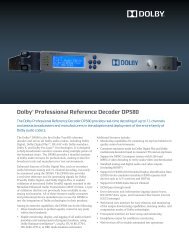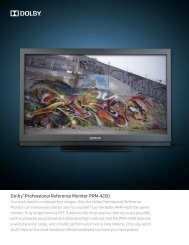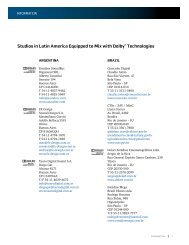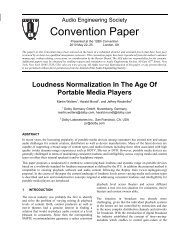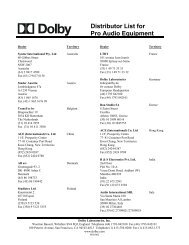Frequently asked QUESTIONS about DOLBY DIGITAL
Frequently asked QUESTIONS about DOLBY DIGITAL
Frequently asked QUESTIONS about DOLBY DIGITAL
Create successful ePaper yourself
Turn your PDF publications into a flip-book with our unique Google optimized e-Paper software.
Figure 17: While five speakers are necessary for home theater (left), Virtual Dolby Surround and Virtual Dolby<br />
Digital (right) provide convingincing surround sound for an individual listener from only two speakers.<br />
32. Is it possible to get<br />
surround sound over<br />
headphones?<br />
Yes, it is now possible to<br />
achieve convincing surround<br />
sound over conventional stereo<br />
headphones from both 5.1channel<br />
Dolby Digital and fourchannel<br />
Dolby Surround-encoded<br />
programs, thanks to a new<br />
development called Dolby<br />
Headphone (see Figure 18).<br />
Figure 18: Dolby Headphone enables convincing<br />
surround sound over conventional stereo<br />
headphones by electronically imparting the unique<br />
sonic signatures of speakers in a listening room.<br />
Dolby Headphone is a signal<br />
processor that recreates the<br />
sound of a real five-speaker<br />
surround system playing multichannel<br />
material in an actual<br />
listening room. It works by electronically<br />
imparting to each<br />
audio channel—two on stereo<br />
programs and up to five on<br />
surround programs—the unique<br />
sonic signature of a corresponding<br />
speaker properly placed in a<br />
carefully-defined acoustic<br />
environment. The processor<br />
combines the signatures into two<br />
composite channels that deliver<br />
to your ears, via conventional<br />
stereo headphones, the sum of<br />
the direct and reflected sounds<br />
from each virtual speaker in the<br />
virtual room.<br />
With conventional headphone<br />
listening, by contrast, the<br />
sound is fed directly to your<br />
eardrums without these spatial<br />
cues. The result is an unnaturally<br />
flat image, with left and right<br />
sounds directly beside you, and<br />
center sounds within your head.<br />
This “in-head” effect is not only<br />
unrealistic, but can also be tiring.<br />
Dolby Headphone works with<br />
both stereo and multichannel<br />
program sources, and can be<br />
included in just <strong>about</strong> any product<br />
with a headphone jack,<br />
including set-top boxes, VCRs,<br />
DVD players, conventional and<br />
digital TV receivers, PCs and<br />
laptops, and A/V surround<br />
decoders and receivers.<br />
33. Does Dolby plan to<br />
introduce higher datarate<br />
versions of Dolby<br />
Digital?<br />
While all Dolby Digital decoders<br />
are capable of handling data<br />
rates as high as 640 kb/s, the 448<br />
kb/s rate used on DVDs (the<br />
maximum allowable) provides<br />
sound quality that critical<br />
listening tests have consistently<br />
confirmed as on a par with<br />
original master tapes. It would<br />
require the introduction of a new<br />
delivery format before the option<br />
to use more than 448 kb/s would<br />
even be considered.<br />
34. I’ve heard that Dolby<br />
Digital isn’t as good as<br />
some competing systems.<br />
Is this true?<br />
No, it’s not. In fact, most such<br />
statements are based on the<br />
assumption that “more is better,”<br />
and not on proper listening tests.<br />
To understand what’s going<br />
on with respect to Dolby Digital<br />
and competing systems, you first<br />
need to know something <strong>about</strong><br />
“perceptual” digital audio coding.<br />
Conventional digital audio, like<br />
that used on CDs, encodes the<br />
audio using 16-bit PCM (pulse<br />
code modulation), which expresses<br />
the value of the original<br />
analog waveform in each channel<br />
to one of 65,536 possible levels,<br />
44,100 times per second. This<br />
already takes up a lot of storage<br />
and transmission space for<br />
plain stereo, so providing<br />
multiple channels of PCM for<br />
surround sound has been<br />
impractical, particularly for<br />
media that also has to carry<br />
data-hungry digital video.<br />
As a result, Dolby Digital and<br />
other coding systems (such as<br />
MPEG, DTS, and ATRAC) have<br />
been developed to save space by<br />
transmitting only the data that’s<br />
necessary to portray the original<br />
sound based on what we can<br />
actually hear, as opposed to<br />
delivering the original PCM data<br />
bit-for-bit. As a result, these are<br />
sometimes known as “perceptual”<br />
or “lossy” coding systems.<br />
A complex coding scheme, or<br />
algorithm, processes the audio<br />
signal based on the principles of<br />
psychoacoustics, the science of<br />
how we perceive sound. The<br />
coder takes advantage of noise<br />
and frequency masking to allow<br />
capturing the audio with just<br />
enough precision to make sure it<br />
sounds the same as the original.<br />
The more powerful the algorithm,<br />
the more precisely the encoder<br />
can shave bits without affecting<br />
the perceived sound quality. This<br />
is why some coder technologies<br />
such as Dolby Digital can sound<br />
just as good as others like DTS<br />
which use from two to four times<br />
as much data.<br />
Dolby Digital’s algorithm,<br />
technically known as Dolby AC-3,<br />
is based upon Dolby Laboratories’<br />
9



